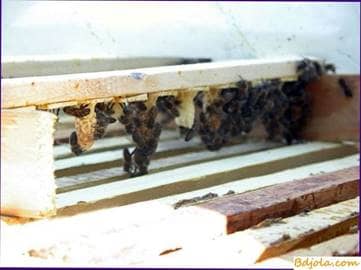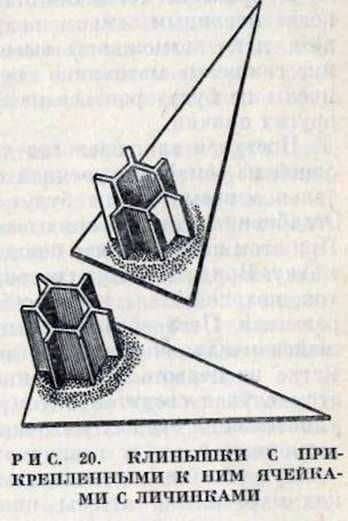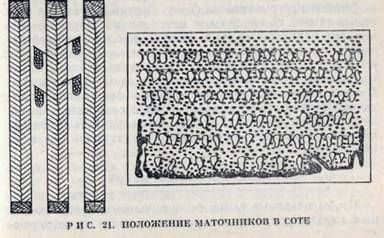Withdrawal of queens

In farms that have strong bee colonies, early supporting honey harvest and late main bribes, which allow obtaining more marketable honey, they practice early withdrawal of queens. Since there will be no drones in early spring, they are taken to the best breeding families in advance. At the same time, it is taken into account that 16 days are required for the development of the lacquer, and the drone 24 days. After exiting the queen cell, the uterus is able to mate on the 7th-10th day, and the drone on the 8th-14th day. Proceeding from this, father’s families cook 10-12 days earlier than families that breed the queens.
For the education of drones in the pre-compressed nests of several of the best strong bee colonies, give 1-2 syrups of brown honeycomb with a large number of drone cells and feeding.
In early spring, because of bad weather, bees do not always have the ability to bring food. In this case, the best incentive feeding will be feeding honey bee to honey bee or sugar paste. And yet the bees will master little larvae, they will not give them enough royal jelly, as a result the uterus is underdeveloped and unproductive. The following year, many of them bees change or they become reared, the latter put infertile eggs in uninfected cells.
For the departure of the queens to mate with the drones, a temperature of 25-27 њ C is required. In spring, this temperature is not often, therefore, after prolonged inclement weather, some of the queens fly off for mating at 20-22 њ C. However, in the literature there are reports of the possibility of insemination of queens in colder weather.
In some years spring is cold, the uterus for a long time does not mate because of lack of heat. In beekeeping practice, it is customary to wait for the beginning of egg laying by the uterus within a month from the day it emerges from the mother liquor. It is believed that after a month period
Summarizing the above, it should be concluded that the early uterus contributes to an increase in the total number of bees, to increase the collection of honey, wax and other products, but because of poor quality they are only suitable for one-time use. Leave them for the winter should not be; if they did, they will change it in the next year.
In the central regions of the country, the best term for the withdrawal of queens is the middle of May, when fruit trees are blooming, relatively warm weather is established, and in printed bee colonies there is a printed drone brood, so there is no need to specifically remove the drones.
In the autumnless hours, the queens are removed as a last resort, since after the flowering of plants the bees of well-off families are expelled by the drones. For the safety of drones, fathers’ families are fed daily, their uterus is replaced by barren uterus. And yet after each flight the drones gradually scatter over the other hives, are expelled and perish.
Practice has established that the most developed and prolific are the uterus, which came from the royal queen. This is explained by the fact that in families that have come into a swarm state, the best microconditions for the development of larvae and uterus sharply reduce the laying of eggs, the mass of which increases. Of them, the most qualitative offspring are born.
From the first minutes of the appearance of the uterine larva, she receives abundant uterine forage. However, in this reception of getting the queens there is a significant disadvantage. Using queen cells from swarming bee colonies, we involuntarily breed swarm bees, which is highly undesirable, since low-value families are valuable for production. They rarely swarm and lay little queen cells, so it is possible to get enough young queens from them only with the artificial creation of a swarm state in the family, by significantly increasing it by brood from other families.
The other conclusion of the queens is based on the numbness of the family, it is called the artificial withdrawal of the queens. There are 2 ways of this withdrawal of queens: with the transfer of larvae and without their transfer.
The withdrawal of the queens without transferring the larvae is simple, reliable and requires no skills. It is based on the fact that in the presence of supporting honey in a highly productive, strong, with sufficient fodder reserves and a well-insulated family, the uterus is removed, which is used to form the layer.

Fig. 19. The filbert
Usually, in the middle of the honeycomb, on the young bee larvae, the bees lay the fistula.
The most valuable will be the uterus, raised on newly hatched larvae from eggs. Uteras raised on larvae older than 3 days of age have transitional forms that combine signs and uterus and working bees: they have smaller sizes and body weight, there are wax glands, baskets, etc. Therefore, in order to prevent the emergence of substandard queens, bee colonies examine on the 3rd or 4th day after the removal of the uterus.
At this time, unsealed queen cells will be laid on 1- and 2-day larvae, of which the most qualitative uterus will emerge. All printed queen cells are torn down. Some beekeepers do this in a different way. They notice printed and open queen cells. When all the queen cells are sealed, the queen cells, laid on the 2- and 3-larvae of the larvae, are torn off. The printed queen cells do not break at once, believing that the bees, instead of the withdrawn queen cells, will lay new ones, perhaps on the larvae of an older age.
Ripe mothers on the 9-10th day are cut out together with a piece of honeycomb triangular shape. The corresponding hole is cut out among the printed brood of a honeycomb, well-crouched by bees in the center of the nest of the family, which is substituted for the motherhood. For the reliability of fastening the honeycomb carefully, not to touch the mother, pinned with a wire or a thin nail to the honeycomb.
To avoid the excision of queen cells from several honeycombs, which results in damage to the honeycombs and partial death of the brood, it is possible to make all the queen cells compactly packed on one honeycomb on the newly emerged larvae and under the most favorable conditions of the nest. To do this, proceed as follows. In the center of the nest (better in the isolator) put a light brown honeycomb, sprinkled with syrup. The honeycombs are monitored to determine when the uterus begins to lay eggs in it. On the 4th day after the start of egg laying, the honeycomb from the nest is removed and transferred to a warm, humid room. The temperature in it should be within 25-30 њ C, humidity of air – 75-85%.
To moisten the room, the floor is poured hot water, hanging wet towels or bags. A suitable place for conducting the corresponding work can be a cucumber greenhouse.
Since the bee larvae require constant care, work must be done quickly, so that the larvae outside the nest are less than 1 hour.
In the honeycomb, select a site with the youngest larvae, preferably in the middle or at the top of the honeycomb. Cut a strip of height 4 cm so as not to damage the walls of the upper cells. To facilitate the work of bees to rebuild the bee cells in the queen cells, they are cut off with a half sharp sharp knife. To ensure that the bees do not rebuild the grouped joined queen cells, two adjacent larvae are removed, leaving one in each third cell.
To give the cells in which the queen cells are left, the species of the little bowl are slightly widened by their rounded rod, without touching the larvae. In appearance, the cells will look like uterine bowls, and the bees will quickly start feeding larvae in them. On the opposite side of the honeycomb, the larvae of the lower row are completely removed.
It is also easy to remove the queens on wedges or cartridges. To do this, from the frame cut strips of honeycombs with uterine larvae so that there is one row of cells intact with a knife. Then the cells with the selected larvae are half shortened. The strip is cut into pieces one by one with a larva. As in the first example, the truncated part of the cell is shaped like a bowl, and the opposite side after removal of the larva with a fused wax is attached to the cartridge or wedge.

Cartridges with larvae are fixed in a special frame, and cells in wedges are stuck in dark honeycombs with brood every 2 cm.

A great influence on the reception by the bees of larvae on the uterine upbringing and on the quality of the raised queens is provided by the family-educator. According to the physiological condition, the family should by this time finish growing and be predisposed to swarming. It is important not to violate the deadline for setting larvae for uterine upbringing (after 5-6 hours of removal of the uterus).
The bees, along with the larvae they put on their breeding, will, in addition, in different places of the nest, have fistular queen cells. Therefore, a week later, the family is examined to remove these fistulous queen cells. Simultaneously, the culling of substandard (excessively long and short, thin and curved) queen cells is carried out. At the same time, the number of larvae accepted for uterine upbringing is established. If the mother cells are not enough, they organize another family-educator.
On the 9th-10th day after larvae are put on for uterine upbringing, queen cells are taken and used for their intended purpose. Unused queen cells are isolated in cells and left in the nest for ripening. To access the bees to the queen cells, the top of the valves in the uterine cells is left open. The bees penetrating into the cell reduce the layer of the queen’s signet, facilitate the exit of the uterus, and, most importantly, will feed it in the mother liquor. It is established that by gnawing the cap of the mother liquor, the uterus receives food from the bees. The fed uterus is not in a hurry to leave the motherhood, lingering and ripening in it for another 6 to 24 hours or more. As a result of the access of bees to the queen cells, the uterus leaves more mature, brightly colored and mobile.
It happens that a bright uterus emerges from the mother liquor. It can be mistaken for an underdeveloped one. You do not need to change it. Color does not affect the work of the uterus, eventually it will darken.
In the practice of hothouse beekeeping, there are cases when bee families, obtained from division by flight, are given the opportunity to take out a new uterus. Excess fistula queen cells do not remove, hoping that the bees will not swarm due to medication and other causes.
In doing so, the beekeeper allows two errors at once. In one of the families, obtained from dividing by half a year, the bees will be inactive for a long time. Weakened family brings up less quality queens. In this case, it is believed that the bees themselves will choose the best uterus. It is unlikely that bees are able to recognize the quality of queens found in queen cells in different stages of development. Beekeeper practitioners know that only a good uterus from the first sealed queen cell always comes out of the bee colonies. The role of bees in this case is reduced to – whether to allow the uterus to destroy the mature queen cells or not to give it this opportunity in view of the secondary and subsequent swarming.
With a quiet change of the uterus, despite the presence of several queen cells, the bees never allow the exit of the uterus from the second queen cell, he and other queen cells are always gnashed out from the side. Another situation in bee colonies with fistula mothers. The first is always the worst uterus, raised on a bee larva of older age. It is not necessary to talk about the expediency of nature here. Raising bees in the queen bees is a phenomenon for bees. On the scale of evolutionary development, it emerged recently as a result of an inefficient human invasion of the life of bees. Therefore, as it was said above, it is necessary to remove fistula mothers laid on older larvae.
Withdrawal of queens
